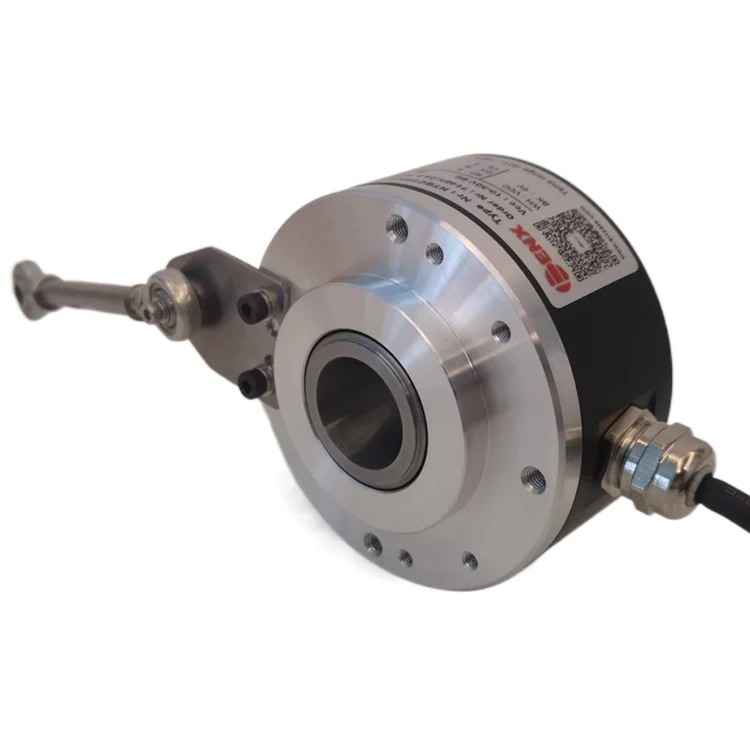- This topic is empty.
-
AuthorPosts
-
18/06/2025 at 17:44 #8829
In modern industrial automation, the ability to accurately monitor motion parameters such as speed, angle, distance, and trajectory is essential. The incremental rotary encoder, a key component in this domain, provides real-time feedback signals that inform control systems about mechanical movement. Its high resolution, stability, and adaptability make it an indispensable sensor in various demanding environments and equipment. In this blog post, as a high quality hollow shaft incremental rotary encoder exporter, ENX Enxiao will share the application range of industrial grade incremental rotary encoder for sale.
1. Fundamentals of Incremental Rotary Encoders
Before delving into specific applications, it' s important to understand the working principle of incremental rotary encoders. These devices convert mechanical motion into electrical pulses, which can then be interpreted to determine the speed and position of rotating elements. Unlike absolute encoders, incremental models do not retain positional information when powered off, but they excel in dynamic applications that prioritize high-speed and high-frequency feedback.
Industrial-grade incremental encoders are designed for harsh environments, with robust enclosures, enhanced resistance to vibration and shock, and precise signal output. Their versatility is further amplified by compatibility with various communication protocols and mechanical configurations.
2. Port Lifting and Transportation Machinery
In the realm of port and cargo handling, reliability and speed are paramount. Cranes, container stackers, and gantry systems rely on incremental rotary encoders for real-time motion control.
* Speed and Position Feedback: Encoders mounted on motors or winch drums deliver crucial information about lifting speeds, cable extension length, and load trajectory.
* Enhanced Safety: By monitoring angular rotation and detecting anomalies, the system can implement emergency braking or halts, minimizing risks.
* Position Synchronization: Encoders facilitate synchronized movement of multi-axis lifting components to ensure balanced load handling and precise container placement.
In this environment, incremental encoders must endure outdoor conditions including dust, humidity, temperature fluctuations, and mechanical impact.
3. Wind Power Generation Equipment
Wind turbines, both onshore and offshore, are subjected to dynamic environmental forces and require precise control for energy efficiency and structural safety. Incremental rotary encoders are used in several subsystems of wind energy generation:
* Yaw and Pitch Control Systems: Encoders track the rotation angle of nacelles and the pitch angle of turbine blades, ensuring optimal alignment with wind direction.
* Generator Speed Regulation: Accurate speed measurement of the rotor and generator shaft is critical for stable electrical output and synchronization with the grid.
* Condition Monitoring: By analyzing variations in speed or rotational behavior, early detection of component wear or failure is possible, reducing downtime.
Industrial-grade encoders used in turbines are built to withstand extreme temperatures, high winds, and electromagnetic interference, making them reliable under prolonged stress.
4. Iron and Steel Metallurgical Equipment
The steel and metallurgical industry involves large-scale and continuous operations under high-temperature, dusty, and corrosive conditions. Incremental rotary encoders play a vital role in process automation:
* Roller and Conveyor Monitoring: In continuous casting and rolling lines, encoders ensure precise control of speed and position of rollers and conveyors to achieve uniform product dimensions.
* Crane and Hoist Positioning: Foundry cranes use encoders for exact movement control, helping to transport molten metal safely.
* Rotational Feedback for Motors: Key machinery such as rotary kilns, drives, and turntables require accurate rotational data for stable operation.
Encoders installed in such settings often incorporate sealed housings, reinforced shafts, and thermal insulation to survive severe environmental conditions.

5. Paper Printing and Textile Machinery
Precision and repeatability are fundamental in printing and textile manufacturing, where any deviation in speed or position can lead to material waste and reduced product quality.
* Speed Control: Encoders provide real-time data for regulating the motor speeds driving print rollers or looms.
* Web Tension and Alignment: During continuous feed processes, encoders help maintain consistent material tension and alignment, reducing misprints or pattern distortions.
* Registration Mark Detection: When paired with sensors, encoders contribute to high-accuracy mark registration and cut-to-length operations.
Incremental encoders in this sector are designed to handle continuous duty cycles, fine resolutions, and integration with advanced PLC systems.
6. Large Drives and Generators
Heavy-duty industrial equipment, such as large electric motors and power generators, require robust feedback mechanisms for effective control and protection.
* Dynamic Speed Feedback: Large drives used in mining, cement production, or water treatment depend on encoders to regulate torque and rotation under fluctuating loads.
* Start-Stop Monitoring: Encoders help monitor and control startup or shutdown sequences in generators to avoid mechanical stress or synchronization faults.
* Load Sharing and Synchronization: When multiple motors or generators operate in parallel, encoders ensure their output remains synchronized for balanced power distribution.
In these applications, the encoder' s ability to maintain accuracy under high inertia and variable operating conditions is critical.
7. Trajectory and Tilt Measurement
Certain advanced encoder systems are integrated with inclinometer or accelerometer functions to monitor tilt and motion trajectory. Though incremental encoders by themselves don't measure tilt, they contribute to composite sensor systems in applications such as:
* Mobile Cranes and Aerial Platforms: Real-time tilt feedback helps prevent overturning and ensures safe operation.
* Automated Guided Vehicles (AGVs): Precise trajectory tracking enables smooth and accurate navigation in logistics and manufacturing environments.
* Construction Machinery: Motion tracking ensures accurate digging, lifting, and leveling in earth-moving and civil engineering operations.
In such cases, the encoder' s speed and angular displacement data are fused with other sensors to derive complete motion dynamics.
8. Operational Environment Considerations
While incremental rotary encoders are widely used, it is important to note that the standard industrial-grade versions are not explosion-proof. Therefore, they are unsuitable for use in environments with flammable gases, vapors, or dust unless a certified explosion-proof model is specifically integrated.
Nonetheless, in non-explosion-proof industrial environments, their performance remains outstanding across all key parameters—robustness, precision, cost-effectiveness, and versatility.
Conclusion
Industrial-grade incremental rotary encoders are foundational to modern motion control and automation systems. Their ability to translate mechanical motion into accurate, high-resolution electrical signals makes them suitable for a diverse range of industries—from maritime and renewable energy to heavy manufacturing and precision machinery. As industrial demands evolve toward smarter and more resilient systems, incremental encoders continue to adapt, proving their indispensable role in the future of industrial automation.
http://www.enxsensors.com
ENX Enxiao -
AuthorPosts
- You must be logged in to reply to this topic.



